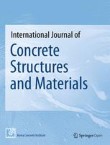International Journal of Concrete Structures and Materials is affiliated with Korea Concrete Institute.
Flexural Improvement of RC Slabs by FRP or Steel Using Different Strengthening Systems and Novel Anchoring Techniques
An experimental study on reinforced concrete one-way slabs strengthened by various methods and materials is introduced in this paper. Innovative anchorage procedures are presented and evaluated to prevent the ...

